How to Stay Competitive as a Sole Proprietor

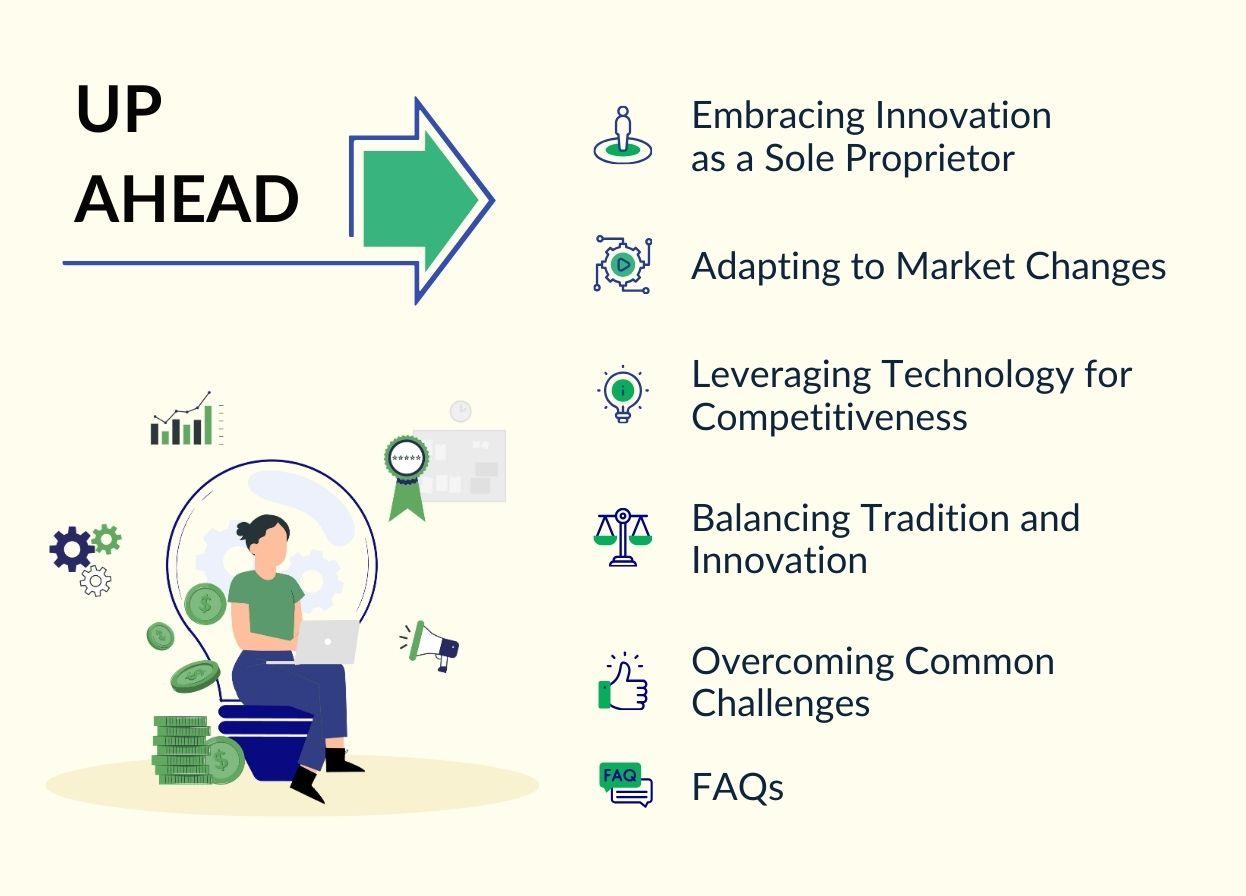

“You don’t need to have a 100-person company to develop that idea.” ~ Larry Page, Co-founder of Google
When you, as a sole proprietor, cover all aspects of your business (finance, resource management, branding, technology, and customer satisfaction) you must solve all major challenges, too:
- Owner-dependence syndrome
- Scale and management issues
- Working capital requirements
On top of these, staying relevant and above the competitors is needed to grow an excellent business.
95% of the 30,000 new products introduced each year fail due to poor innovation. With millions of sole proprietorship businesses, delivering successful product after product remains a tall order. Here’s how you can identify challenges and their consequences and develop strategies for successfully implementing innovation in a sole proprietor business.
Embracing Innovation as a Sole Proprietor
Innovation is a key marker for staying relevant and achieving success in any business; sole proprietorship is no different. As a proprietor, you must constantly iterate and reiterate your marketing and product strategies, business models, processes, etc.
Look at Apple, Microsoft, Amazon, and other big corporations that began small, in a garage or a rented room. They embraced innovation and did things differently when no one else dared to. Apple’s partnership with Microsoft, a competitor, was a risk-taking move that gave us the iMac and changed the company’s fortunes.
There are so many aspects a proprietor can explore. Some different forms of innovation can be:
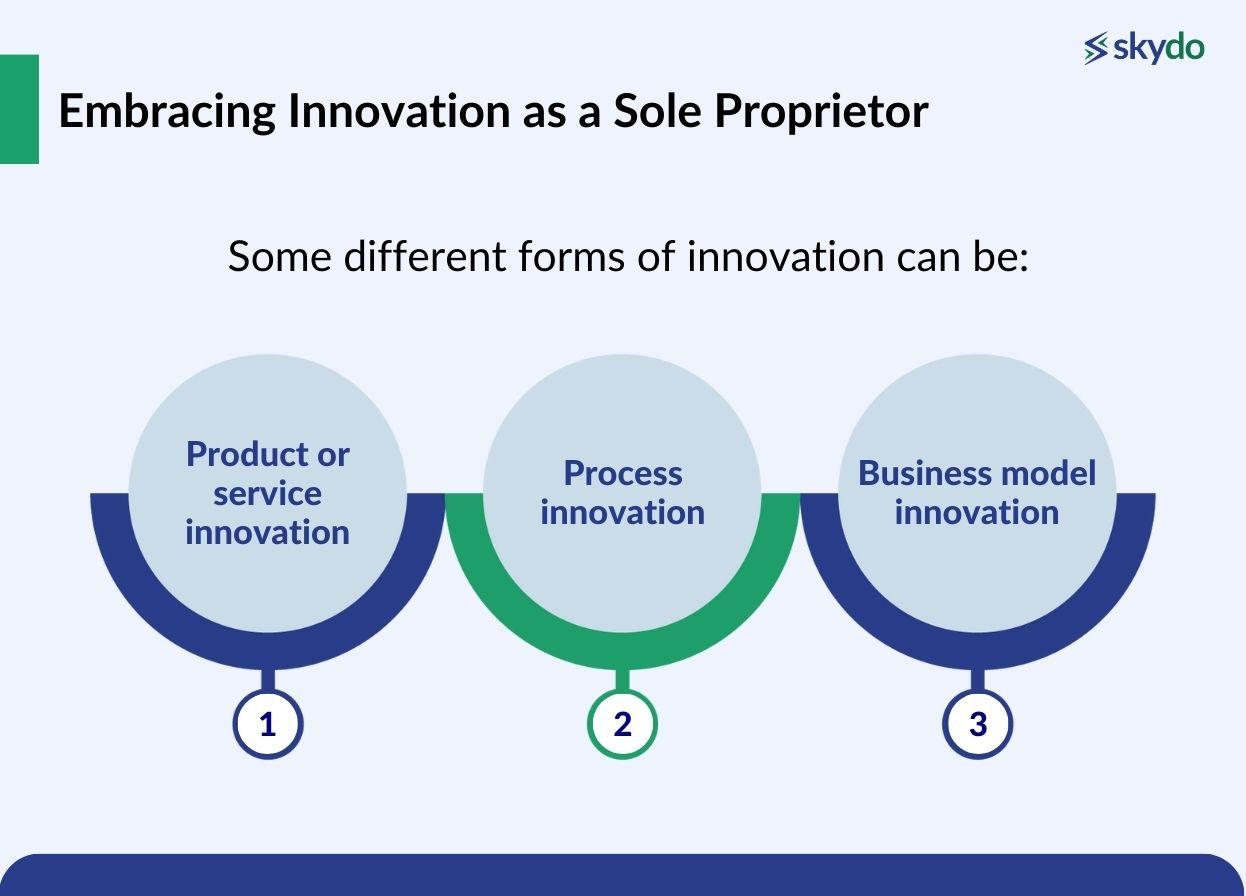
- Product or service innovation: Improving an existing service or product or developing a new product altogether is the most common way entrepreneurs explore innovation in their businesses. An innovation should solve user problems and suit their tastes and preferences.
- Process innovation: Another useful move is to add automation to your native processes or improve their efficiency through changes in procurement, inventory management, production, etc.
- Business model innovation: You could be restructuring your business to integrate new technologies or targeting new audiences and markets. Modifying the business model is a crucial decision and must be carefully considered.
Here are some benefits of exploring such innovations for sole proprietors:
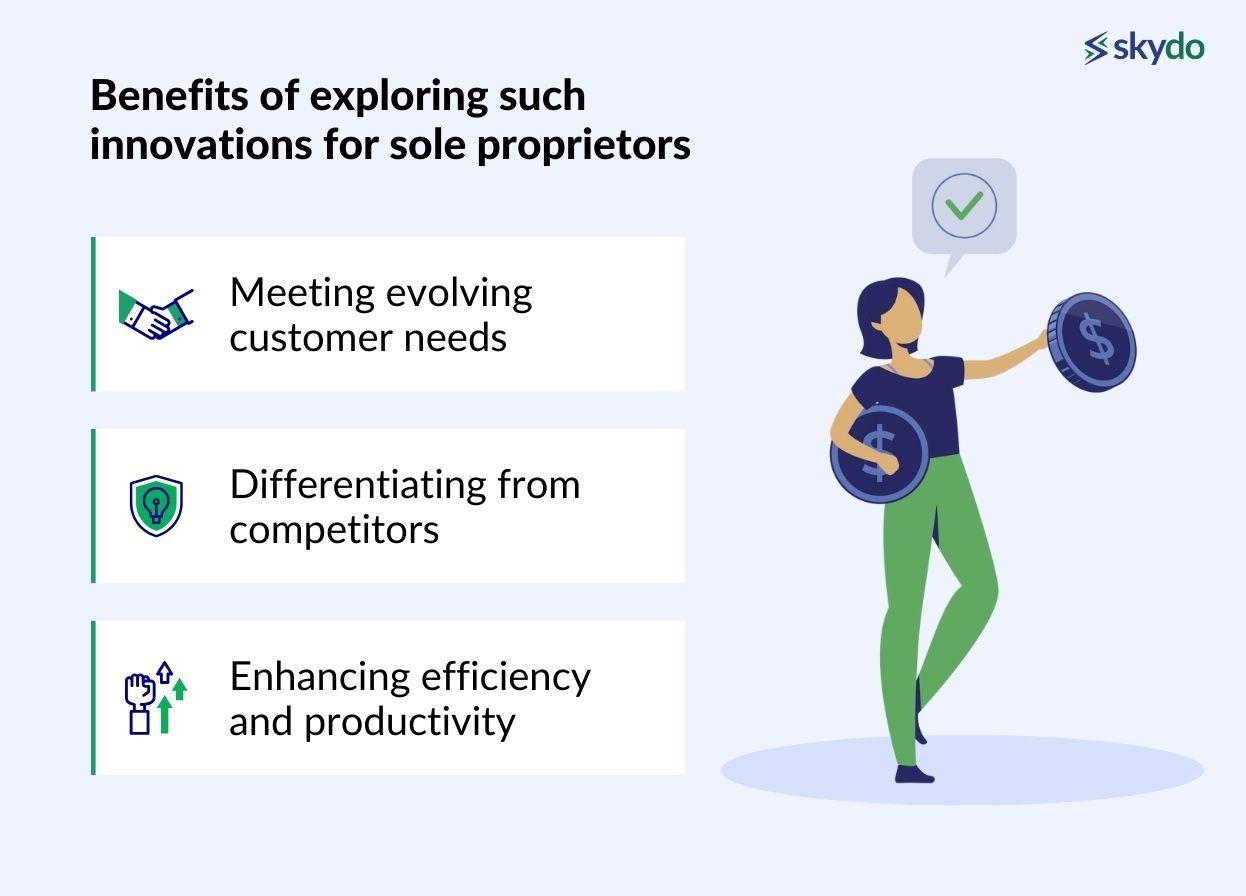
- Meeting evolving customer needs: With time, it is necessary to cater to the changing customer needs and preferences to keep the relevance of your product intact. For instance, McDonald's has a new menu for its consumers from every geography.
- Differentiating from competitors: As a sole proprietor, building your product or service’s USP can go a long way in sustaining your growth and sales. IKEA used augmented reality for its 2011 catalog to differentiate its print catalog. Ultimately, customers were spending double the time browsing the catalog.
- Enhancing efficiency and productivity: It is mostly you managing all the aspects of your business. Here, the funds are limited. As such, efficiency and productivity can become your partners while treading the obstacles in day-to-day business operations.
Adapting to Market Changes
Data from the Ministry of Corporate Affairs finds that 55% of businesses do not survive despite the sole proprietors' passion, funds, and talents. Either the owners cannot translate their idea into a substantial product, or they can’t stay in the loop with the changing times. Recognising the inevitability of market changes is mandatory while aligning the processes and products.
Amazon showed this by realigning its strategy of promoting itself as the biggest bookstore against competitors like Barnes & Noble and Waldenbooks. Next, we knew Amazon was dominating as the e-commerce and cloud computing giant.
Thus, it is important to monitor industry trends and stay informed. Here is how
- Following relevant news and developments: The business space is ever-evolving and is impacted by externalities and industry-specific events. Keeping in touch with peers and competitors and keeping abreast of the latest industry developments can add stability to your business.
- Attending conferences and networking events: What’s better than attending conferences and seminars to keep up with the industry trends? Proprietorship is a lonely affair and requires staying informed to reinvent and reform with changing times.
Once you are aware of the industry scenario, these are some strategies for effective adaptation -
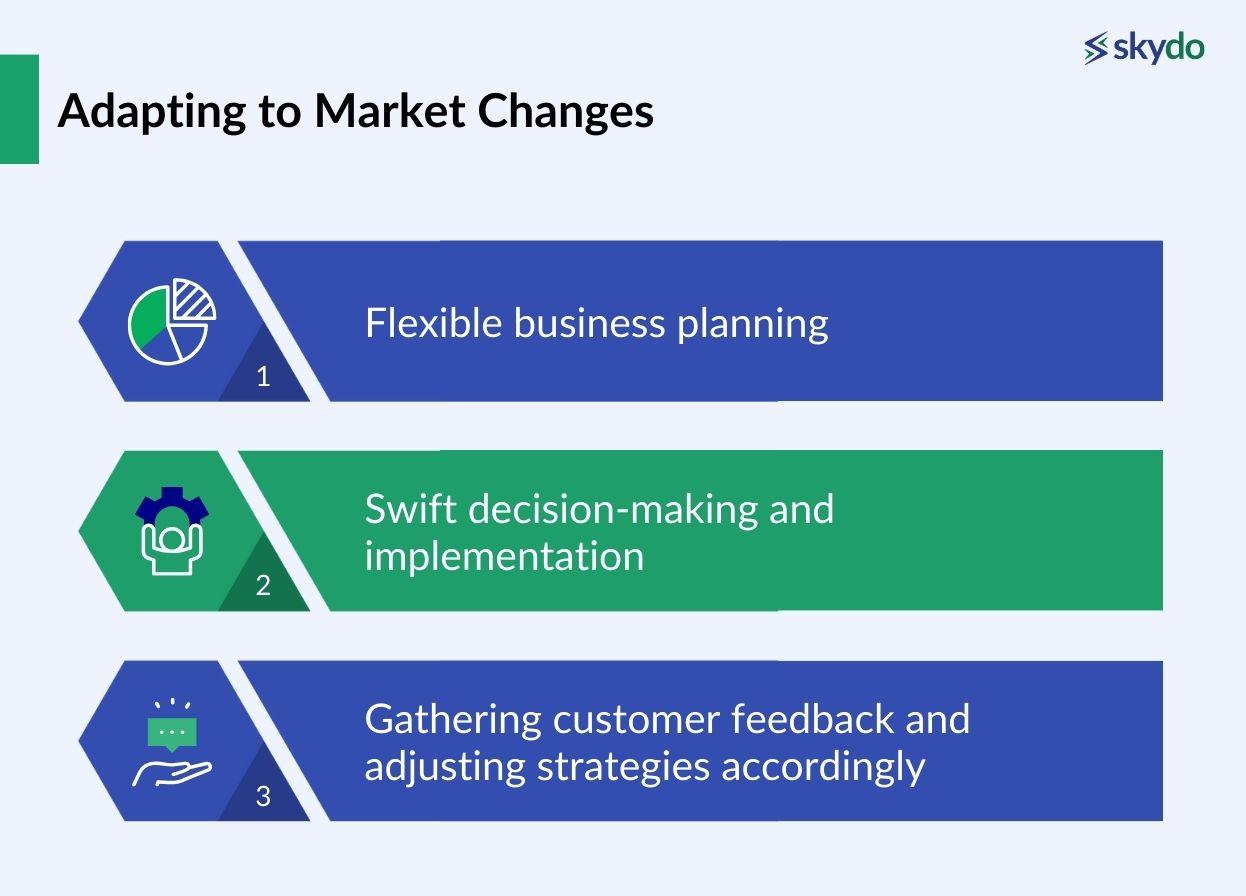
- Flexible business planning: In a proprietorship, there’s no divide between the owner and the firm. You are also at complete liberty to make any changes in your business without losing time or opportunity.
- Swift decision-making and implementation: Flexibility and the zero requirement for setting up board meetings, following procedures, etc., grants business owners swift decision-making. Anything not working in your favor can be swiftly fixed and implemented.
- Gathering customer feedback and adjusting strategies accordingly: Similarly, entrepreneurs can engage in one-on-one customer interactions or designate an employee to collect customer feedback to bring co-creation into the business.
Leveraging Technology for Competitiveness
Have you ever heard of Chipotle Mexican Grill – the fast food player? Earlier running on a counter-service model, the brand modified itself into a drive-thru pickup lane. The company heavily invested in technology to develop these ‘Chipotlanes’ for mobile pickup orders.
Importance of Technology for Businesses
- Impact on Culture and Relationships: No matter your business size, technology significantly influences your culture and relationships. Sole proprietors must recognize technology-driven opportunities, such as the choice of website and communication methods. Quick, clear, and real-time interactions can enhance customer engagement and improve public image.
- Automation and Digital Tools: The level of automation and digital tools integrated into daily operations affects efficiency and profitability. Choosing the right tools can streamline processes and reduce costs, contributing to overall business success.
- Data Integration for Business Insights: Collecting data from various channels and consolidating it into a single source (like CRM) allows for in-depth analysis. This valuable insight can tell you who to focus on, what to sell more, preferred mode of communication, etc. aiding in strategic decision-making.
Overcoming Technological Barriers
- Streamlined Adoption: While technology offers benefits like reducing manual work and enhancing security, overcoming technological barriers is crucial for successful adoption. Get over the fear of new tools, push your team to adopt them, and allow for initial mistakes instead of reprimanding them.
- Collaboration and Training: Collaborate with tech-savvy professionals to train employees in new software and technologies. Learning and upskilling are essential components of substantiating tech innovation plans for your business.
- Outsourcing for Cost-Effective Solutions: If internal tech integration appears costly, consider outsourcing technical tasks - you can then access expertise without a significant upfront investment.
Balancing Tradition and Innovation
Legacy businesses carry tradition as a bedrock of their corporate identity. Tradition lies in the essence of the brand and its history, but shouldn’t get in the way of innovation. Acknowledging the value of traditional business practices is as essential as integrating innovation without compromising on your core values.
Innovation doesn’t mean a mass upheaval from the old to the new processes. It is more about identifying aspects open to evolution. Figure out how the existing processes can be refreshed and adapted to modern needs while still rooted in tradition and old values.
Being single owner-led identities, sole proprietorships enjoy the flexibility and dynamism. See that there is a gradual implementation of changes rather than a hurried attempt without considering customer expectations and business needs.
Overcoming Common Challenges
Resistance to change is inevitable, especially for sole proprietors managing all aspects of their business. Addressing potential challenges is crucial for smoothing the path toward innovation.
People tend to resist change due to comfort with the status quo. Overcoming this requires addressing a lack of skills and knowledge in handling new technologies and managing unrealistic expectations and timelines.
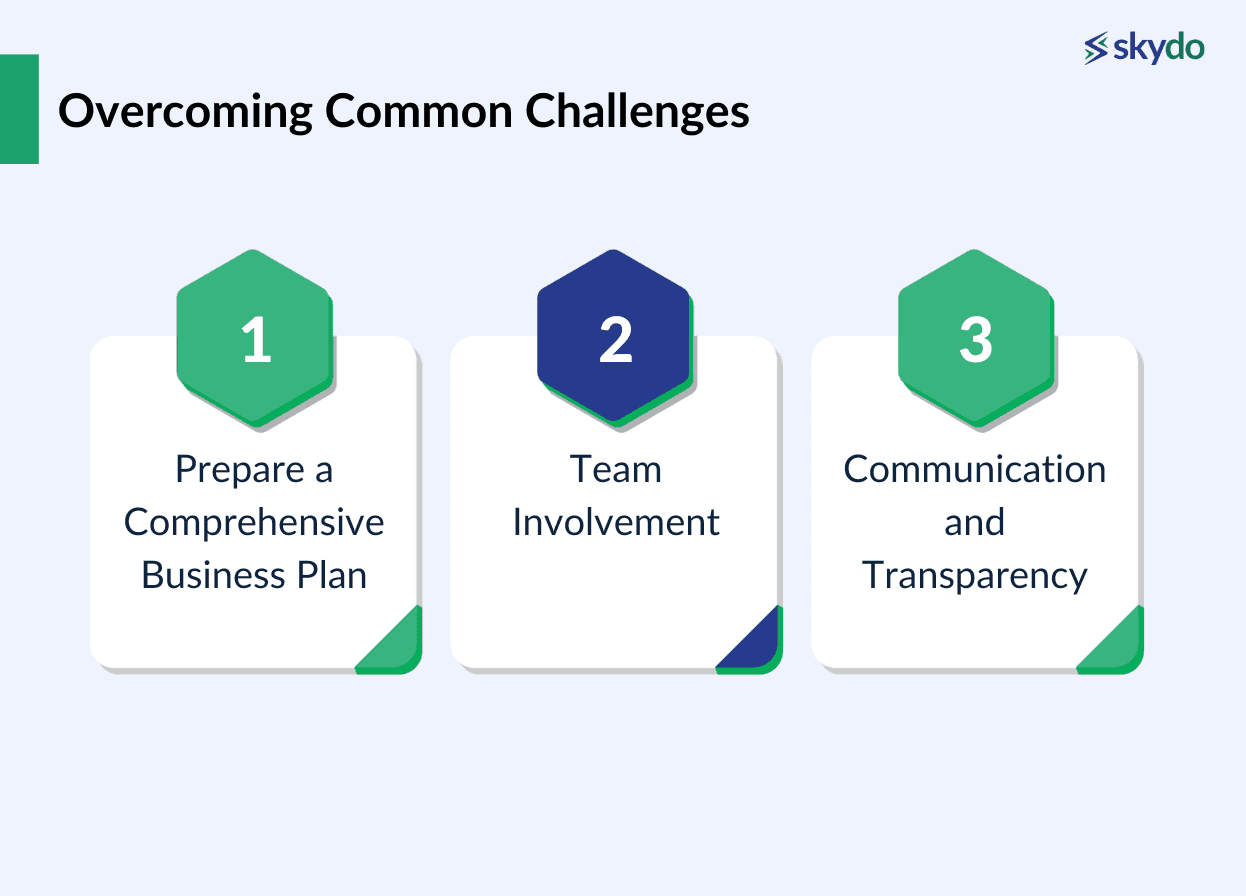
- Prepare a Comprehensive Business Plan: Provide clarity on goals and objectives. Effective communication and transparency are key components in overcoming resistance to change.
- Team Involvement: Involve your team members in the innovation process, fostering a sense of ownership. Solicit their feedback and ideas to make them active participants in the change.
- Communication and Transparency: Highlight the benefits and positive outcomes of the proposed changes in all communications. Lead by example to inspire confidence and trust among your team members.
General Electric underwent a complete overhaul under CEO Jack Welch between 1081 and 1998. But the overhaul wasn’t just in terms of reducing the defects in products and processes. Welch worked on people issues. He formed a team of employees unified in values, beliefs, and vision. From the successful Six Sigma company, an international powerhouse, General Electric was born.
Conclusion
Innovation is the cornerstone of growth and development for any business entity, and sole proprietorship is no different. While staying relevant is the key to staying competitive as a sole proprietor, you cannot compromise your business’s sustainability.
Innovation isn’t a standalone attempt. It should be brought as a business model innovation where each element of your business should be involved in the process. Learning and upskilling for employees, data analytics to gauge the scope for innovation in business processes, and handling customer expectations – all form part of the innovation cycle.
Proprietors must understand the dynamic nature of business and the ongoing journey of staying competitive. Being resilient and flexible, fostering an innovation culture, and celebrating failures as a learning opportunity – you know what it takes to see the new and better.

Frequently Asked Questions
Q1. Which is better: a sole proprietorship or an LLC?
Ans: Choosing between a sole proprietorship and an LLC depends on your needs. Sole props are simple and cheap but offer no personal liability protection. LLCs cost more but shield your personal assets from business debts. Consider potential risks and growth plans to pick the best fit.
Q2. Is Being a Sole Proprietorship the Same As Being Self-Employed?
Ans: Yes, sole proprietors are self-employed. Both terms describe individuals working for themselves, not someone else's payroll.
Q3. How Do I File Taxes As a Sole Proprietor?
Ans: As a sole proprietor, file your income tax return using Schedule BA alongside your personal return (ITR 3 or 4). Report your business income and expenses within this schedule. Deduct legitimate business expenses to reduce taxable income. For specific deductions and regulations, consult a chartered accountant for tax preparation guidance.












